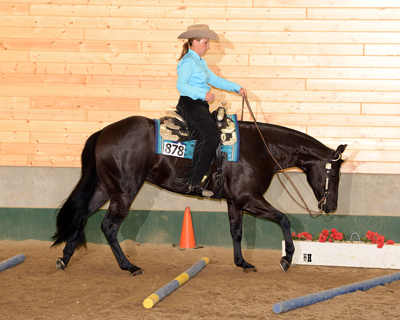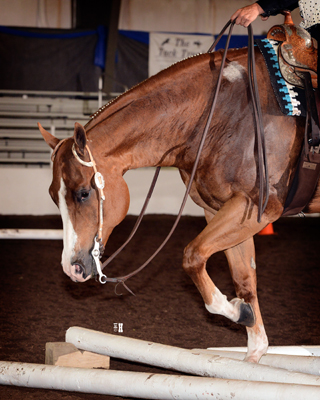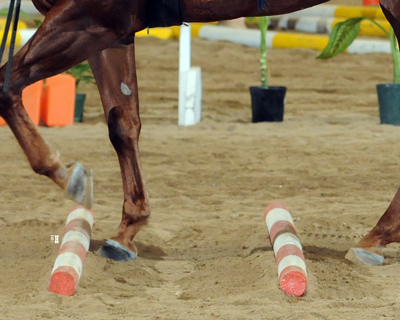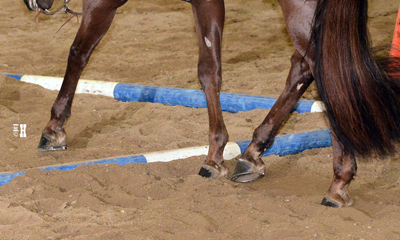 In recent years, the Trail class has become very popular, with much tougher competition. As the level of competition has increased, so has the level of difficulty. The class where show horses that didn’t quite make the pleasure grade found themselves has become a priority class in its own right, with both horses and exhibitors finding it a specialty rather than a second chance class.
In recent years, the Trail class has become very popular, with much tougher competition. As the level of competition has increased, so has the level of difficulty. The class where show horses that didn’t quite make the pleasure grade found themselves has become a priority class in its own right, with both horses and exhibitors finding it a specialty rather than a second chance class.
AQHA Professional Horseman, Joni Nelson, of Long Grove, Iowa, is a trainer who is known nationwide for producing top Trail competitors. “Three things make certain horses better at trail than others,” says Nelson. “Their movement, their mind and the way they use their feet over the poles and through the slow maneuvers and the box.”
PICKING YOUR PROSPECT
“Trail has become a much tougher class,” she admits. “With the ability of the horses today and the degree of difficulty of the courses, you have to have a pretty good mover. I tend to like the ones that lope over poles like they were loping in a Pleasure class, but obviously with more forward motion than you see on the rail. The horses that already have good cadence and a good lope are really easy to teach the lope overs, it’s usually just teaching them where to land before the pole and the rest is easy.”
Nelson wants to see horses that can lope a six foot stride comfortably. If they can do a one-stride lope over, be comfortable and not change their pace much, it’s going to work. Horses that have a short stride will have to go through the obstacle at a faster speed or they will constantly hit the poles. The horse with a longer stride will often hit their toes to the poles, but that is easier to correct than stretching a short stride.
“I don’t want a horse to be a really tight jogger to start with. One that has a longer stride at the jog is usually easier to get over the poles and to get the correct strides in between the poles if they are in a sequence. Since Trail is based upon a three foot stride at the trot, I want the horse to be comfortable taking that three foot stride,” she says.
She says it should be easy for them. “I want to be able to control that stride, so I don’t want a horse to go at a fast pace to get that stride because that will be more difficult to control later on in training.”
If the horse is not comfortable at that stride then they won’t be comfortable over the poles and will not have the confidence going over the higher poles eventually.”
“I really look at the way horses use their feet,” she says. “You can usually tell if a horse will be good over the poles when you first start. It’s just like every other discipline, if it is easy for them when you start them, and they feel confident and it seems natural for them, then they are a pretty good prospect for the class.”
 Nelson prefers a horse that is bigger, or a smaller horse with a bigger stride. A small stride is not ideal and neither is a very long stride.
Nelson prefers a horse that is bigger, or a smaller horse with a bigger stride. A small stride is not ideal and neither is a very long stride.
“When I start a horse, I like to see them pay attention to the poles and try to get over them,” she explains. “Even if they hit them, as long as they are trying to figure it out and realize they don’t want to hit the poles, or they don’t panic about hitting the poles, I’m good with that.”
Nelson also says she likes horses that are coordinated in their feet, especially when it comes to turning in the box, navigating the elevated poles at the gate and making the corner in the back through obstacles.
“I also look for a horse that is good in their mind to be able to do a sequence of lope overs and then slow their mind down to go directly to a back through or walk overs,” she says. “The more busy-minded horses seem to take more time to teach the slow stuff and slow their minds down for tight guiding obstacles.”
Nelson says she feels these horses will take a more experienced rider that can keep their own nerves in check while showing, where the quieter minded ones seem to take everything one step at a time, making them the better choice for non-pro riders.
“The quiet mind really helps when it comes to your back through, gate and walk over obstacles,” she says. “They are much easier to teach everything but a horse that’s too dull will make the training difficult as well. The dull horses can be harder to teach to guide and get over the poles clean.”
STARTING THE EDUCATION
Nelson begins to teach her horses trail after they understand how to lope collected and slow and jog collected at several different paces. When they can move all of their body parts, give to pressure off the spur and know how to give to the bridle, and guide. “All of these pieces are extremely important!” she stresses. “A super solid foundation is the key to starting green trail horses. We almost do not start a Trail horse until it understands how to do the Pleasure. To us, Pleasure is our starting foundation, just as you wouldn’t expect a horse to just start jumping without the foundation work of the flat classes.”
 Joni, and her husband Craig, like to get the horses that have been shown in western pleasure and are ready for a change or addition to their events. “They seem to train up the quickest because you don’t have to teach them to move off your spur when it comes to things like the back through and they give in their face and stay rounded and collected. They already know their transitions, which is a huge thing to have,” she says. “We’ve had a lot of success doing it this way. I had one come from a Pleasure trainer and in just two weeks I was showing him in Trail and getting points. The ones that don’t have that solid Pleasure foundation seem to take longer.”
Joni, and her husband Craig, like to get the horses that have been shown in western pleasure and are ready for a change or addition to their events. “They seem to train up the quickest because you don’t have to teach them to move off your spur when it comes to things like the back through and they give in their face and stay rounded and collected. They already know their transitions, which is a huge thing to have,” she says. “We’ve had a lot of success doing it this way. I had one come from a Pleasure trainer and in just two weeks I was showing him in Trail and getting points. The ones that don’t have that solid Pleasure foundation seem to take longer.”
Nelson estimates that it takes anywhere from four months, with an exceptional horse, to ten months to train a trail horse that has already been started. “If I would choose the most important quality a horse needs to start training in trail, it would have to be that they must GUIDE easily.”
“When we first start our Trail horses, we begin by trotting and loping over poles, straight lines and pinwheels,” she explains. “I think it is important when you teach them to get that first step correctly placed before the first pole. If you can master that then it will be easier for them. If you teach them to get too close to the pole they will hit it or they will learn the tendency to snub up to the poles, resulting in unwanted hits of the pole. You don’t want them to land too far from the pole or they will be reaching and it’s tough for them to keep a good, soft rhythm as well.”
Nelson teaches them to keep lift and cadence over the poles and to keep focused as well. “Once they seem to get the hang of the lope and trot overs, we move to the box and the walk overs,” she says. Nelson recommends having 15-20 poles at home for training/practice.
Teaching a horse to follow his nose in a tight circle before you begin work in the box helps to get the front feet crossing over and that is what, eventually, leads to the fancy speed in that turnaround box.
 Walk overs are done at a slow pace to teach the horse to put his foot right in the middle of the space between the poles. “Getting control and having control of their feet is really important here,” advises Nelson. “You need to be able to tell the horse exactly where to place his feet with your cues, and tell them which foot goes where.”
Walk overs are done at a slow pace to teach the horse to put his foot right in the middle of the space between the poles. “Getting control and having control of their feet is really important here,” advises Nelson. “You need to be able to tell the horse exactly where to place his feet with your cues, and tell them which foot goes where.”
Once she is able to control those feet in the walk overs, they move to the back through obstacles. Before starting to work on backing obstacles, Nelson makes sure the horse is able to back a straight line and has control to perform a quarter turn on both the forehand and the haunches before she introduces the poles. “This obstacle needs to be done slowly every day, you can always introduce speed later,” she says. “Just work on the first part, like the straight line back, then add a push the hip around the corner, then add moving the shoulders around the corner and then the straight line back again. We don’t add another part until they can perfect the part you are on.”
Nelson approaches the gate in the same fashion. “Make sure they understand the each part of the gate sequence before you add a step over pole,” she says.
BUILDING A LESSON PLAN
Nelson works her horses on Trail every time she gets them out to ride. She also works several days a week on exercises to keep her horses listening to her leg cues and works on their movement at least three to four times a week, if not every day.
“The greener horses get worked on all the obstacles they know,” she says. “We work on lots of guiding and keeping their legs pretty over the poles. Extra time is spent on any obstacle that gives them problems. The more they figure Trail out, the more I challenge them by adding difficulty to the maneuvers and that’s when I start to add the elevated poles.”
On her older, seasoned horses, Nelson works more on their legs to keep their movement pretty and schools on any obstacle that is difficult for them.
“They might just go over a few elevated poles at the most. Those horses know how to do it right, so there is no reason to keep drilling them until they make a mistake. You want them to enjoy Trail,” she says. “Closer to the shows, we do more difficult maneuvers and the poles will get higher at home. We spend a lot of time making the slow stuff more accurate and correct because those are hard obstacles to plus. The more you work on those the better you will get and the easier it will become to add the speed required to plus at the bigger shows.” Nelson cautions against sacrificing control for speed, however.
 PATTERN PRACTICE
PATTERN PRACTICE
Several shows have patterns posted online prior to the show. “I do not recommend putting that entire pattern up at home and riding through it several times before the show.” Nelson does review the patterns at home and looks for areas that may be difficult for her horse, setting that obstacle up for schooling at home and working the kinks out.
She does the same at a show. “We don’t practice the entire pattern in full, but instead work on the parts until we feel they understand and are comfortable. This being said, it’s good when a horse knows what’s coming up in the pattern so they can help you if you need it, but they are still allowing you to control them.”
A strong Pleasure foundation gives a horse the good transitions that have become key in many of the patterns used today. The trot to lope and lope to trot must be solid before you go into the show pen.
 KEEPING THEM FRESH
KEEPING THEM FRESH
“Once the Trail horse knows its job, it’s fun!” Nelson admits it’s almost as hard keeping one fresh as it is to make one. “You need to keep them good and honest in the pen, but yet not school them so hard in the pen that they hate going in there.”
The same goes for working them at home. “Once they know their job, let them do it. School them when they need it, but in a way they won’t learn to dislike their job,” she recommends. “If you keep getting the same result then it’s up to you to think about how you are addressing the situation. If you go at the problem the same way, school it the same way, and get the same undesirable result, then you need to change the way you are going about it. Think outside the box and go back to your basics.”
“All in all, I think it boils down to having a good foundation to be successful in starting one in Trail. It has to be a pretty mover to excel, and it needs to be a horse you like, because you will be spending a lot of time with that horse. It should be fun for both of you.”
About Joni Nelson
Joni Nelson, along with her husband, Craig, trains Trail and all around horses in Long Grove, Iowa. She started showing the evenet in 2007 and since then has shown three Congress Champions and four Reserve Congress Champions, including first and second in Green Trail the same year. She’s placed in the Top 5 and Top 10 at the AQHA World Show. Together, Joni and Craig have trained five AQHA World Champions and three Reserve World Champions, more than 20 Congress Champions (five in Trail, six Reserve Congress Champions in Trail), and multiple AQHA High Point title horses. As a member of AQHA’s Team Wrangler, Joni Nelson was the 2012 Team Wrangler Leading Exhibitor, earning over 1,200 points in a year’s time. At the 2013 AQHA World Championship Show, Joni trained five horses that showed in the Junior Trail Preliminaries, with three of those horses making the finals. One finished Top 5, the other two were Top 10 and the fifth horse from the prelims missed the finals by just one-half point. “We’ve been lucky to have so many good horses, it’s hard to pick one to brag on.” That list includes Hes Pretty Good, Too Hot To Frisk, RR Moonlite Mister, Some Kinda Lazy, Lets Shake Em Up, Zips In It To Win It, One Hot Drama Mama, Leaguers Gone Roan, Mister Spontaneous, Some Kinda Lazy and Hotrods R Lucky Too. As of Dec.31, 2013, Nelson has 2,510 AQHA trail points on her record. “I love Trail because of the control you need to make a good horse and have a good go at a show. I love that it is a scored event, and that on any given day, any horse or rider entered in that class could win the class. Even the best riders and best horses have bad days. Probably the thing I like the least about Trail is that if you have a problem in the show pen, there is not a chance that the judge didn’t see it and there’s no way for you to cover it up.


One Response to "Perfecting the Trail Poles"
You must be logged in to post a comment Login